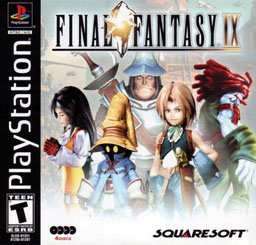
Final Fantasy IX is a 2000 role-playing video game developed and published by Square for the PlayStation video game console. It is the ninth game in the main Final Fantasy series. The plot focuses on a war between nations in a medieval fantasy world called Gaia. Players follow a thief named Zidane Tribal who kidnaps princess Garnet Til Alexandros XVII as part of a ploy by the neighboring nation of Lindblum. He joins Garnet and a growing cast of characters on a quest to take down her mother, Queen Brahne of Alexandria, who started the war.
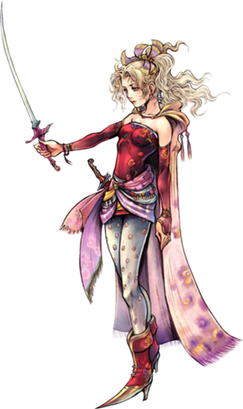
Terra Branford, known as Tina Branford in Japanese media, is a character in the Final Fantasy series and the main protagonist of Final Fantasy VI. Yoshitaka Amano and Tetsuya Nomura designed her for the main series installment, with Kazuko Shibuya designing her in-game sprites alongside the rest of the characters. She also appears in the spin-off fighting game series Dissidia Final Fantasy and the rhythm series Theatrhythm Final Fantasy. She has made small appearances in several other games in and outside the Final Fantasy series.
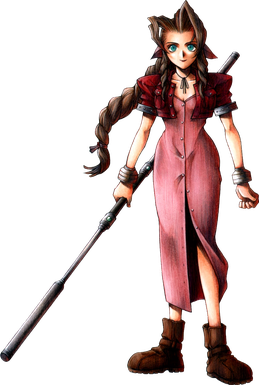
Aerith Gainsborough, transliterated as Aeris Gainsborough in the English releases of Final Fantasy VII and Final Fantasy Tactics, is a character in Square's role-playing video game Final Fantasy VII. She was designed by Tetsuya Nomura with influence from Yoshinori Kitase, Hironobu Sakaguchi and Yoshitaka Amano.

Celes Chere is a character and protagonist in the video game Final Fantasy VI. She was created by Yoshinori Kitase and was his favorite character in the game. She struggles with allegiances between the Empire and the rebel group, the Returners before ultimately siding with the latter. She appears in other Final Fantasy titles, including the Theatrhythm series and World of Final Fantasy.

Zidane Tribal is a video game character in the Final Fantasy series and the main protagonist of Final Fantasy IX. He was conceived and written by Hironobu Sakaguchi, while his appearance was designed by Yoshitaka Amano and re-interpreted by Toshiyuki Itahana. Like other members of the Final Fantasy IX cast, but unlike characters of previous Final Fantasy games, Zidane was designed after the plot for the game was written. Presented as a charming, puckish character, Zidane has an outgoing, self-confident and womanizing personality whose mixture of lechery and devil-may-care attitude helps put danger into perspective.
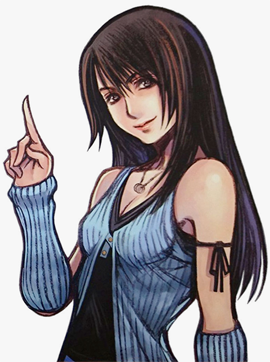
Rinoa Heartilly is a character and the co-protagonist of Square's 1999 role-playing video game Final Fantasy VIII. She is a teenaged member of a resistance faction known as the Forest Owls. After she recruits protagonist Squall Leonhart and his friends, she decides to stay with his group and falls in love with Squall in the process. During their adventure, she is briefly possessed by the evil sorceress Ultimecia and becomes a sorceress herself once the spirit leaves her body. After defeating Ultimecia, Rinoa and Squall become a couple. Rinoa has also made cameo appearances in other Final Fantasy and Square Enix games.
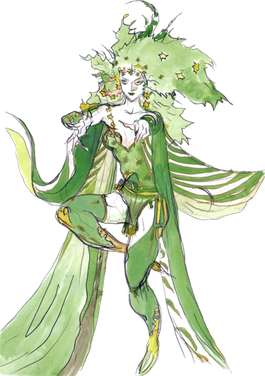
Rydia of Mist is a fictional character in the Final Fantasy series. She appears in Final Fantasy IV as one of its protagonists. She is able to summon entities, as can others from her village. She was created by Yoshitaka Amano. Her design in Final Fantasy IV: The After Years was controversial, resulting in it being censored for an international release.
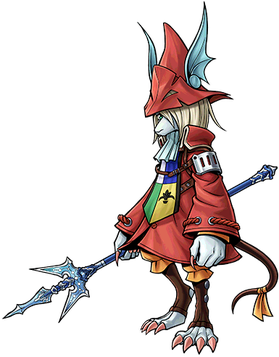
Freya Crescent is a fictional character in the 2000 video game Final Fantasy IX, where she is one of the main characters. She is an anthropomorphic rat called a Burmecian, and a Dragoon Knight. She is on a quest to find her lost love, Sir Fratley, only to discover that he has forgotten her due to amnesia. She also suffers from the destruction of different Burmecian cities. She was originally conceived by Yoshitaka Amano, before her final version was created by Toshiyuki Itahana.

Final Fantasy IX, a PlayStation role-playing game consisting of four CD-ROMs, features a cast containing various major and minor characters. Players control a maximum of four characters for combat at once, with eight main playable characters in the party and other, temporary characters.

Faris Scherwiz is a character in the Final Fantasy series. She first appears in Final Fantasy V as an early antagonist and later one of its protagonists. She was born Princess Sarisa Scherwil Tycoon, but was lost at sea and raised as a boy by pirates. She joins the group, hoping to understand why protagonist Lenna Charlotte Tycoon has the same pendant as her. She was created by Hironobu Sakaguchi and was based on the protagonist of the manga Princess Knight. Her promotional artwork was created by Yoshitaka Amano.

Beatrix is a fictional character in the 2000 video game Final Fantasy IX. She is one of its antagonists, serving Queen Brahne of the Alexandria Kingdom as Brahne invades various nations to steal crystal shards. Beatrix eventually betrays Brahne after the destruction of the nation of Cleyra and Brahne putting the life of the Princess, Garnet, at risk. She works with Steiner to battle against Brahne, and eventually falls in love with him. She has been a generally popular character among critics and fans, with her eventual turn away from Brahne and her power receiving commentary from critics.
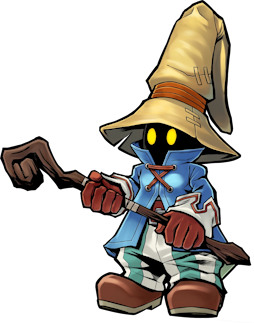
Vivi Ornitier is a video game character in the Final Fantasy series. He appears in the video game Final Fantasy IX, where he serves as a member of the game's main cast. He is a shy character who through the game's plot grapples with the trauma of discovering his past and identity. He is a Black Mage, a class of magic users who employ fire, ice, lightning, and other elements into their magic. His design took inspiration from the film The Dark Crystal and was meant to appear both realistic and comic-like; part of the game's world was designed around him in turn. He has appeared in other games such as the Theatrhythm Final Fantasy series, Kingdom Hearts II, and World of Final Fantasy. A felt doll of Vivi was included with pre-orders of the Japanese original release of FFIX.

Dissidia Final Fantasy is a fighting game with action role-playing elements developed and published by Square Enix for the PlayStation Portable as part of the campaign for the Final Fantasy series' 20th anniversary. It was released in Japan on December 18, 2008, in North America on August 25, 2009, and in Australia and Europe in September. It was then re-released in Japan, based on the North American version, as Dissidia Final Fantasy: Universal Tuning, on November 1, 2009.
Yuna is a character from Square Enix's Final Fantasy series. She was introduced as the female protagonist, and one of the main playable characters of the 2001 role-playing video game Final Fantasy X. She appears as a summoner embarking on a journey to defeat the world-threatening monster, Sin, alongside her companions, including the male protagonist, Tidus. Yuna reappears in Final Fantasy X-2, where she becomes the protagonist, searching for a way to find Tidus two years after his disappearance. Other Square Enix games have featured Yuna, notably Dissidia 012 Final Fantasy.

Rikku is a character in the Final Fantasy series, created by Tetsuya Nomura. Rikku first appears in Final Fantasy X as one of its protagonists, where she accompanies her cousin Yuna and others on a journey to defeat the monster Sin. Rikku again appears as a protagonist in the game's direct sequel, Final Fantasy X-2. In that game, she, Yuna, and new friend Paine journey to find missing FFX protagonist Tidus.
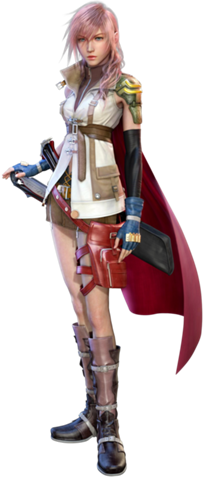
Lightning is a character from the Final Fantasy video game series made by Square Enix. She first appeared as a playable character and the main protagonist in the role-playing video game Final Fantasy XIII, in which she is a resident of the artificial world of Cocoon. After her sister Serah is declared an enemy of Cocoon, Lightning attempts to save her and is chosen by divine powers to destroy Cocoon. Lightning reappears as a supporting character in Final Fantasy XIII-2, acting as protector of the Goddess Etro. She is the sole playable character in Lightning Returns: Final Fantasy XIII, wherein she sets out to save the people of her dying world. Outside the XIII series, Lightning has been featured in multiple Final Fantasy games and had cameo appearances in other video games.

Theatrhythm Final Fantasy is a rhythm video game, developed by indieszero and published by Square Enix for Nintendo 3DS and iOS. Based on the Final Fantasy video game franchise, the game involves using the touch screen in time to various pieces of music from the series. The game was released in Japan in February 2012, and in North America, Australia and Europe in July. An iOS version was released in December. A sequel, Theatrhythm Final Fantasy: Curtain Call, was released in 2014. A third game based on the Dragon Quest series, Theatrhythm Dragon Quest, was released in 2015. An arcade game, Theatrhythm Final Fantasy: All-Star Carnival, was released in 2016. A second sequel, Theatrhythm Final Bar Line, was released on February 16, 2023 for Nintendo Switch and PlayStation 4.

Theatrhythm Final Fantasy: Curtain Call is a rhythm video game. A sequel to the 2012 video game Theatrhythm Final Fantasy and the second title in the rhythm series, it features similar gameplay to its predecessor. It was released for the Nintendo 3DS on April 24, 2014 in Japan, and in September for other markets.
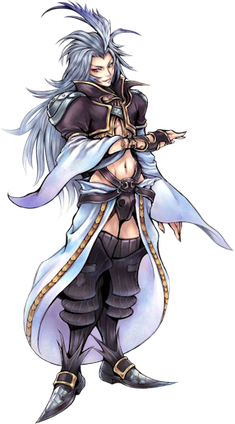
Kuja is a fictional character and the main antagonist of the 2000 video game Final Fantasy IX. A member of the same race as the protagonist, Zidane. He exhibits narcissistic and egomaniacal traits, with his plot at first being to overthrow his creator, and then to destroy all life. He appears in other games, such as Dissidia Final Fantasy. His concept art was created by Yoshitaka Amano, which was later reimagined by Toshiyuki Itahana.

Quina Quen is a character in the video game Final Fantasy IX, being one of the playable characters that can be used. They are a Blue Mage, a Final Fantasy class that gains enemies' powers by defeating them, and is invested in eating food. They have an ambiguous gender, referred to with both male and female pronouns in the English version of the game. They join the protagonist, Zidane Tribal, as part of their own quest to learn about life beyond food.




















